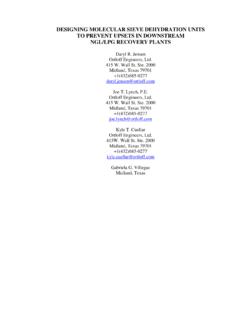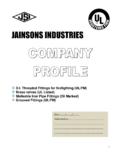Transcription of GAS PLANT IN A BOTTLE - Ortloff
1 - 1 - GAS PLANT IN A BOTTLE John D. Wilkinson, , Hank M. Hudson, , Joe T. Lynch, , Steve J. Munden, and Scott A. Miller Ortloff Engineers, Ltd. Midland, Texas, USA Kyle T. Cuellar Ortloff Engineers, Ltd. Katy, Texas, USA Andrew F. Johnke and W. Larry Lewis, SME Products, Houston, Texas, USA Abstract A new process design and equipment concept has been developed for reducing the cost and plot space required for gas processing. Through innovative use of integrated heat and mass transfer equipment, most of the processing equipment found in a typical cryogenic gas PLANT can now be placed inside a single vertical tower or " BOTTLE ".
2 With the " BOTTLE " concept, the cryogenic PLANT is reduced to a single processing assembly coupled to an adjoining turbo-expander module, significantly reducing the cryogenic PLANT footprint. Much of the piping used to join the equipment items together in a typical gas PLANT is eliminated by placing the equipment services inside the tower, including most of the residue gas piping. All of the heat transfer devices are inside the tower, eliminating the external reboilers, the often troublesome thermosiphon reboiler piping, and issues with heat exchanger thermal stress sometimes found in standard gas plants .
3 Among the advantages of this concept are lower PLANT cost, less plot space, less piping, reduced pressure drop with resulting lower compression power, fewer flanged connections reducing the potential sources of leaks and atmospheric emissions, fewer foundations meaning less civil work, and shorter construction schedules. Gas PLANT in a BOTTLE (GPB) designs can use state-of-the-art Ortloff natural gas liquids or liquefied petroleum gas (NGL / LPG) technologies, which offer the highest efficiencies for extracting liquids from natural gas, or industry standard open-art technology, such as Ortloff s Gas Subcooled Process (GSP) design.
4 Technology selection is based on the processing requirements and product economics for each PLANT site. - 2 - Introduction Recent market forecasts and surveys indicate the production of natural gas liquids (NGL - defined as ethane, LPG, and heavier hydrocarbons), both within the United States and globally, is expected to increase through ,2,3,4 Further development of gas processing technology that is more cost effective, operationally efficient, and environmentally responsible becomes critical for the investing Gas processing projects can generally be divided into two categories.
5 Contaminant removal and liquids Within the liquids recovery category, the criteria to be considered for any project are initial capital investment, ongoing processing costs, operating efficiency, safety and environmental considerations, tolerance to carbon dioxide (CO2) contamination, and operating flexibility to either recover or reject ethane without sacrificing operating efficiency, propane recovery, or the flexibility to operate at turndown conditions. Ortloff Engineers, Ltd. (OEL) and SME Products, (SME-P) have teamed up to develop the next generation of gas processing liquids extraction plants which incorporate the operational efficiency of OEL s state-of-the-art liquids recovery technology, OEL s process design know-how, and SME-P s equipment design and packaging expertise.
6 Gas PLANT in a BOTTLE (GPB) is a new, innovative technology developed with gas processing companies in mind who are seeking an even further improvement in overall NGL profit margins while reducing potential environmental emissions sources. The process details and benefits of the GPB technology will be described further in the remainder of this paper. The BOTTLE Concept Gas PLANT in a BOTTLE (GPB) uses a combination of heat and mass transfer devices all within the fractionation assembly. Most, if not all, of the heat exchange, component separation, and mass transfer/distillation equipment are in one processing assembly.
7 One key feature of the GPB is the Heat and Mass Transfer (HMT) module which is incorporated into the stripping section of the fractionation column, providing external heat input to generate stripping vapors and mass transfer contact within the HMT module to improve the fractionation. The BOTTLE Process A typical cryogenic gas PLANT process design for ethane recovery will be used to illustrate the differences between a traditional turbo-expander gas processing PLANT design and the new GPB design. For this illustration, Ortloff s Gas Subcooled Process (GSP) design will be the process used for comparison to the Gas Subcooled Process in a BOTTLE (GSP-B ) in an ethane recovery GSP-B is one of several processes that can be constructed - 3 - using OEL s BOTTLE technology.
8 All process flow paths for the BOTTLE technology are identical to an equivalent, traditional gas processing technology; however, the location of the equipment is changed or eliminated completely in OEL s BOTTLE processes. The simplified process flow diagrams shown below illustrate both the GSP (Figure 1) and GSP-B (Figure 2) arrangements. Figure 1 GSP Process Arrangement Figure 2 GSP-B Process Arrangement The key equipment in the ethane recovery design arrangement for both GSP and GSP-B are the gas/gas heat exchanger (typically a brazed aluminum heat exchanger or BAHE), cold separator, turbo-expander, recompressor, demethanizer fractionation column, subcooler, demethanizer reboilers.
9 For GSP-B , a Heat and Mass Transfer (HMT) module replaces the traditional reboilers and mass transfer stripping section. These equipment items and their locations will be further discussed to compare the process differences between GSP and GSP-B . Heat Exchanger Assembly In most designs, all heat exchange equipment ( gas/gas exchanger, subcooler, and the column side/bottom reboilers) for the GSP is located at grade-level. For the BOTTLE arrangement, the equipment is located within the pressurized vessel assembly above and below the demethanizer absorber section.
10 For both GSP and GSP-B , the inlet feed flow is divided into two streams. Instead of both GSP feed streams exchanging heat in the gas/gas exchanger and reboilers at grade-level, one GSP-B feed stream enters the feed pass of the gas/gas exchanger near the top of the processing assembly, and the second feed stream flows through the HMT module at the base of the demethanizer stripping section. The GSP-B demethanizer overhead flows through the residue gas pass of the subcooler and gas/gas exchanger prior to exiting the pressurized vessel assembly, instead of exiting the - 4 - demethanizer column and flowing into the GSP cold box assembly to pass through the subcooler and gas/gas exchanger at grade-level.















